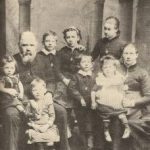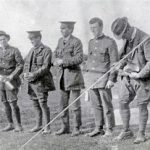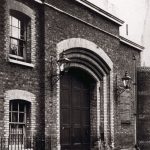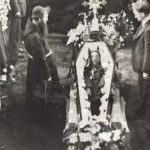Early Life
 Terence MacSwiney or Terry as he was known to his family was born in the city of Cork in March 1879. He was one of eight children. His father, John had an interesting life , he set off to Rome in 1868 to fight as a papal guard against Garibaldi and his nationalist forces, only to find that they had arrived before he got there. He then became a schoolteacher in London before returning to Cork to open a tobacco factory with his brother-in -law. Following the failure of this business, he emigrated to Australia in 1885 leaving Terence and the other children in the care of their mother; he never returned.
Terence MacSwiney or Terry as he was known to his family was born in the city of Cork in March 1879. He was one of eight children. His father, John had an interesting life , he set off to Rome in 1868 to fight as a papal guard against Garibaldi and his nationalist forces, only to find that they had arrived before he got there. He then became a schoolteacher in London before returning to Cork to open a tobacco factory with his brother-in -law. Following the failure of this business, he emigrated to Australia in 1885 leaving Terence and the other children in the care of their mother; he never returned.
Terence’s Mother, Mary was an English Catholic who held strong Irish nationalist opinions. She died when Terence was six years old. It is said that this sad event turned Terence from an outgoing little boy into one who became more studios and introverted.
 Terence was educated by the Christian Brothers at the North Monastery school in Cork city but left at fifteen to help support the family, working as a clerk and later as an accountant for Dwyer’s in Cork. He continued his studies at Cork university in the evenings and graduated with a degree in Mental and Moral Science in 1907.
Terence was educated by the Christian Brothers at the North Monastery school in Cork city but left at fifteen to help support the family, working as a clerk and later as an accountant for Dwyer’s in Cork. He continued his studies at Cork university in the evenings and graduated with a degree in Mental and Moral Science in 1907.
Terence enjoyed writing plays, poetry and pamphlets on Irish history. He was also very committed to the Gaelic revival and helped to found the Celtic Literary Society and the Cork Dramatic Society who staged some of his plays. Interestingly his fifth play ‘The Revolutionist’ took as its theme, the political stand made by one man.
Political activity
Terence, who was a committed Irish Nationalist was one of the founders of the Cork Brigade of the Irish Volunteers in 1913, and was President of the Cork branch of Sinn Féin. In 1914 he founded a newspaper, Fianna Fáil, in 1914, which was suppressed after only 11 issues in April 1916.
 In 1912 Terence gave up his job in Dwyers’ to become a technical teacher, this allowed him to travel all over the county and also train local men to fight in the Irish Volunteers. He would have played a key role in the Easter Rising of 1916 but was ordered to ‘stand his men down’ by Eoin MacNeill when it was realised that British Intelligence had intercepted the German ship transporting their armaments.
In 1912 Terence gave up his job in Dwyers’ to become a technical teacher, this allowed him to travel all over the county and also train local men to fight in the Irish Volunteers. He would have played a key role in the Easter Rising of 1916 but was ordered to ‘stand his men down’ by Eoin MacNeill when it was realised that British Intelligence had intercepted the German ship transporting their armaments.
Following the Rising, he was imprisoned in Reading and Wakefield Gaols until December 1916 by the British Government under the Defence of the Realm Act . In February 1917 he was deported from Ireland and imprisoned in Shrewsbury and Bromyard internment camps until his release in June 1917. It was during his exile in Bromyard that he married Muriel Murphy of the Cork distillery-owning family. In November 1917, he was arrested in Cork for wearing an Irish Republican Army (IRA) uniform and, inspired by the example of Thomas Ashe, went on a hunger strike for three days prior to his release.
In the 1918 general election whilst he was still in gaol, MacSwiney was returned unopposed to the first Dáil Éireann as Sinn Féin representative for Mid Cork. After the murder of his friend Tomás Mac Curtain, the Lord Mayor of Cork on 20 March 1920, MacSwiney , who was his deputy, was elected as Lord Mayor. On 12 August 1920, he was arrested in Cork for possession of “seditous articles and documents”, and also possession of a cipher key. He was court martialled in Cork on the 16th August 1920 and sentenced to two years’ imprisonment at Brixton Prison in England.
Hunger strike
 He immediately started a hunger strike in protest at his internment and the fact that he was tried by a military court. Eleven other Irish Republican prisoners in Cork Jail went on hunger strike at the same time. On 26th August, the British Government stated that “the release of the Lord Mayor would have disastrous results in Ireland and would probably lead to a mutiny of both military and police in south of Ireland.”
He immediately started a hunger strike in protest at his internment and the fact that he was tried by a military court. Eleven other Irish Republican prisoners in Cork Jail went on hunger strike at the same time. On 26th August, the British Government stated that “the release of the Lord Mayor would have disastrous results in Ireland and would probably lead to a mutiny of both military and police in south of Ireland.”
A powerful press campaign led by Art O’Brien and Terence’s sister Min from London ensued with his story rarely out of the press. MacSwiney’s hunger strike gained world attention due in part to the fact that King George V and Lloyd George, his Prime Minister could not agree on whether to release him.
The campaign courted the Americans and the New York dockers (longshoremen) went on strike in support leaving cargo unloaded on the quayside. Strikes were held all over Ireland and protests in places as far away as Argentina took place. A petition was sent to the Prime minister by a Catalan association of Commercial employees.
In Great Britain, Terence’s case was discussed in Parliament, rallies were held in Brixton and Trafalgar Square whilst the King received a heavy postbag on the matter. In spite of this the family were unable to get any workers organisations to down tools in support of Terence.
Terence never gave in – even though food was often placed near him to persuade him to give up the hunger-strike. Attempts at force-feeding MacSwiney were undertaken in the final days of his strike. On 20th October 1920 he fell into a coma and died five days later after 74 days on hunger strike.
 His body lay in St George’s Cathedral, Southwark in London overnight where 30,000 people filed past it. Fearing large-scale demonstrations in Dublin, the authorities diverted his coffin directly to Cork, and his funeral in the Cathedral of St Mary and St Anne on 31st October attracted huge crowds. Terence MacSwiney is buried in the Republican plot in Saint Finbarr’s Cemetery in Cork. Arthur Griffith, the leader of Sinn Fein delivered the graveside oration.
His body lay in St George’s Cathedral, Southwark in London overnight where 30,000 people filed past it. Fearing large-scale demonstrations in Dublin, the authorities diverted his coffin directly to Cork, and his funeral in the Cathedral of St Mary and St Anne on 31st October attracted huge crowds. Terence MacSwiney is buried in the Republican plot in Saint Finbarr’s Cemetery in Cork. Arthur Griffith, the leader of Sinn Fein delivered the graveside oration.